
African Grey Parrot:
Scientific Name: Psittacus erithacus
A native of equatorial Africa, the African grey parrot is known for its intellect and its inherent talent to mimic human speech. Their abilities have made them the most popular attraction amongst our young visitors. The species can be categorised into two general types: the Congo African grey and the Timneh African grey. The origin of the species can be traced to the lowlands of the western and central regions. The average lifespan of an African grey in captivity has been noted to be around 40 to 50 years.
A native of equatorial Africa, the African grey parrot is known for its intellect and its inherent talent to mimic human speech. Their abilities have made them the most popular attraction amongst our young visitors. The species can be categorised into two general types: the Congo African grey and the Timneh African grey. The origin of the species can be traced to the lowlands of the western and central regions. The average lifespan of an African grey in captivity has been noted to be around 40 to 50 years.

Black-Capped Lory:
Scientific Name: Lorius lory
The Black-Capped lory is mostly native to New Guinea and its neighbouring islands. Even though the species is common in the area, the subspecies cyanuchen is comparatively rare and its population is dwindling. These birds live on pollen, nectar, flowers, fruits and insects and they usually move in pairs and occasionally in flocks of 10 or more. Black-capped lories also possess the skills to mimic speech. They are also known for their unique sense of humour, as they enjoy fooling around and can often be seen lying on their backs in these enclosures.
The Black-Capped lory is mostly native to New Guinea and its neighbouring islands. Even though the species is common in the area, the subspecies cyanuchen is comparatively rare and its population is dwindling. These birds live on pollen, nectar, flowers, fruits and insects and they usually move in pairs and occasionally in flocks of 10 or more. Black-capped lories also possess the skills to mimic speech. They are also known for their unique sense of humour, as they enjoy fooling around and can often be seen lying on their backs in these enclosures.

Black Lory:
Scientific Name: Chalcopsitta atra
The Black lory, another resident at EsselWorld Bird Park hails from Indonesia. These birds find homes in the open habitat and the lowland forests of western New Guinea and its surrounding islands. The Black Lory comes in two distinct varieties. The Chalcopsitta atra insignis have a characteristic reddish face, shoulders, thighs and underwings. The other variety Chalcopsitta atra atra of West Papua are typically black.
The Black lory, another resident at EsselWorld Bird Park hails from Indonesia. These birds find homes in the open habitat and the lowland forests of western New Guinea and its surrounding islands. The Black Lory comes in two distinct varieties. The Chalcopsitta atra insignis have a characteristic reddish face, shoulders, thighs and underwings. The other variety Chalcopsitta atra atra of West Papua are typically black.
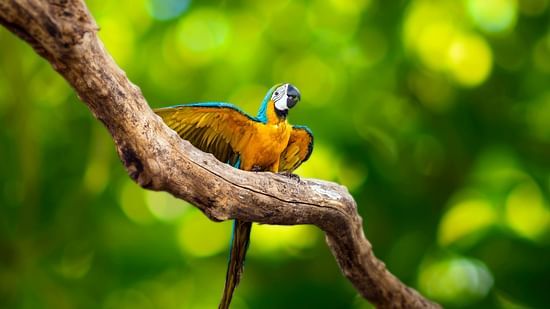
Blue and Yellow Macaw:
Scientific Name: Ara ararauna
The blue and yellow macaw is a member of the Neotropical macaws family. They are the descendants of one of the six genera of Central and South American macaws. These colourful birds are known for their intelligence and social skills that allow them to bond very well to their owners. They make a loving companion to those who genuinely look after their needs. These birds have an average life span of 30-35 years in the wild. They live on nuts and berries, and their string beaks help them break the hard shells of the nuts.
The blue and yellow macaw is a member of the Neotropical macaws family. They are the descendants of one of the six genera of Central and South American macaws. These colourful birds are known for their intelligence and social skills that allow them to bond very well to their owners. They make a loving companion to those who genuinely look after their needs. These birds have an average life span of 30-35 years in the wild. They live on nuts and berries, and their string beaks help them break the hard shells of the nuts.
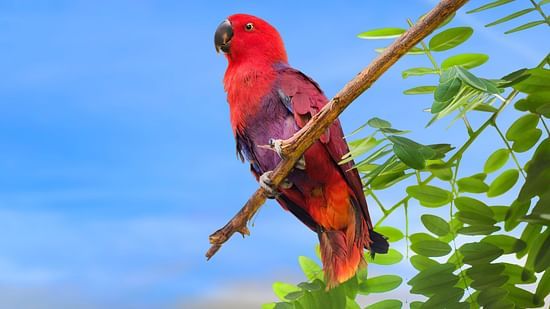
Chattering Lory:
Scientific Name: Lorius garrulous
The chattering lory’s roots lie in North Maluku, Indonesia. It is a forest inhabitant and is constantly under the threat of being captured for the cage-bird trade. These colourful birds are a major subspecies of Lorries. It’s name comes from its habits of chattering throughout the day. Their life expectancy is almost 20 years. The Chattering Lory depends on fresh fruits, vegetables and sprouts for their nutrition. They pass a liquid stool mostly because of their high consumption of nectar.
The chattering lory’s roots lie in North Maluku, Indonesia. It is a forest inhabitant and is constantly under the threat of being captured for the cage-bird trade. These colourful birds are a major subspecies of Lorries. It’s name comes from its habits of chattering throughout the day. Their life expectancy is almost 20 years. The Chattering Lory depends on fresh fruits, vegetables and sprouts for their nutrition. They pass a liquid stool mostly because of their high consumption of nectar.
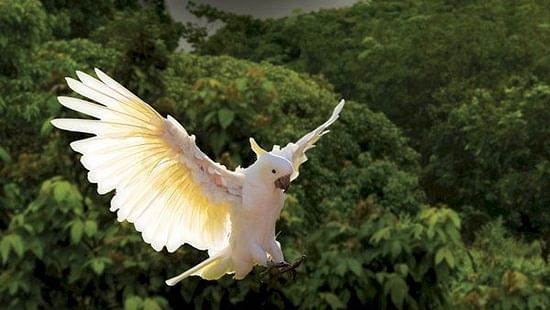
Cockatiel:
Scientific Name: Nymphicus hollandicus
The cockatiel is a descendant of the cockatoo family originating from Australia and is the one and only genus of Nymphicus. They prefer to live in the Australian wetlands, scrub lands and bush lands, and their diet is majorly composed of fruits, vegetables, pellets and seeds. The males often showcase their musical talent by whistling for a prolonged period of time. In contrast, the females, otherwise quiet, shriek only when provoked.
The cockatiel is a descendant of the cockatoo family originating from Australia and is the one and only genus of Nymphicus. They prefer to live in the Australian wetlands, scrub lands and bush lands, and their diet is majorly composed of fruits, vegetables, pellets and seeds. The males often showcase their musical talent by whistling for a prolonged period of time. In contrast, the females, otherwise quiet, shriek only when provoked.
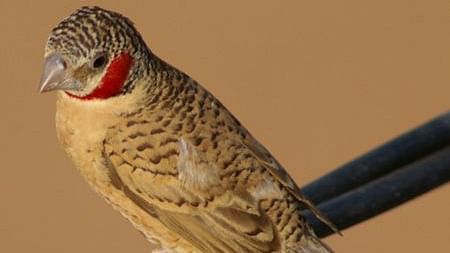
Cut-Throat Finch:
Scientific Name: Amadina fasciata
The cut-throat finch is a widely popular species of estrildid finch found mostly in Africa and can be spotted in the sub-Saharan region especially in the Sahel, eastern and southern parts of the continent. People also identify these birds as the bearded finch, the ribbon finch, the cut throat, and the weaver finch. This particular bird is identifiable by its distinctive plumage which is pale, sandy brown dotted with black flecks. Their tails are a mix of black and brown and they have a chestnut brown patch on their belly. The name “cut-throat” is reflective of the bright red band across the necks of mature males. The cut-throat finch has found a home at our Bird Park, one of the most popular tourist attractions near Mumbai.
The cut-throat finch is a widely popular species of estrildid finch found mostly in Africa and can be spotted in the sub-Saharan region especially in the Sahel, eastern and southern parts of the continent. People also identify these birds as the bearded finch, the ribbon finch, the cut throat, and the weaver finch. This particular bird is identifiable by its distinctive plumage which is pale, sandy brown dotted with black flecks. Their tails are a mix of black and brown and they have a chestnut brown patch on their belly. The name “cut-throat” is reflective of the bright red band across the necks of mature males. The cut-throat finch has found a home at our Bird Park, one of the most popular tourist attractions near Mumbai.

Eclectus Parrot:
Scientific Name: Eclectus roratus
The most characteristic feature of the Eclectus parrot is the difference in colour between the males and the females. While the males are usually green, blue and yellow, the females are bright red and purple. They live on varieties of seeds, nuts, berries, fruits, leaf buds, blossoms and nectar. They are found in small flocks or in pairs. The Eclectus Parrot can live 30 to 40 years. They are known to display light sexual dimorphism, which is implied through the difference in the colours of the males and the females.
The most characteristic feature of the Eclectus parrot is the difference in colour between the males and the females. While the males are usually green, blue and yellow, the females are bright red and purple. They live on varieties of seeds, nuts, berries, fruits, leaf buds, blossoms and nectar. They are found in small flocks or in pairs. The Eclectus Parrot can live 30 to 40 years. They are known to display light sexual dimorphism, which is implied through the difference in the colours of the males and the females.

Galah Cockatoo:
Scientific Name: Eolophus roseicapilla
A native of mainland Australia, the galah cockatoo is the most common of the cockatoos. When in captivity, these birds can live upto the age of 70 or 80. Their life is drastically reduced to 20 years in the wild. They thrive in large flocks in a variety of wood habitats located close to the water. Their diet comprises plants, small seeds, nuts and berries. They employ a special technique to maintain the sharpness of their beaks. They grind or chew objects to do so. These birds have a playful nature and are often seen doing spins or aerobatics when flying. You can also spot them hanging upside down when they land on trees or on wires.
A native of mainland Australia, the galah cockatoo is the most common of the cockatoos. When in captivity, these birds can live upto the age of 70 or 80. Their life is drastically reduced to 20 years in the wild. They thrive in large flocks in a variety of wood habitats located close to the water. Their diet comprises plants, small seeds, nuts and berries. They employ a special technique to maintain the sharpness of their beaks. They grind or chew objects to do so. These birds have a playful nature and are often seen doing spins or aerobatics when flying. You can also spot them hanging upside down when they land on trees or on wires.
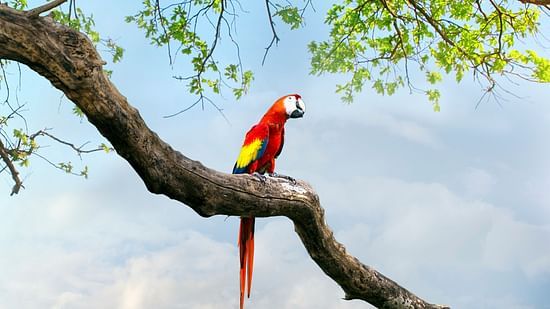
Golden Mantled Rosella:
Scientific Name: Platycercus Eximius
The golden-mantled rosella is the most colourful parrot in the Rosella family. It hails from Australia and is characterised by its bright colours including shades of red, green and blue. The eastern rosella inhabits the southeast regions of the Australian continent and some regions of Tasmania. They are also found in New Zealand, in the North Island and in the hilly regions around Dunedin, albeit the population of these birds here are relatively low mostly because of the colder climate of the region compared to their habitat. They are also frequently caged and sold further contributing to their dwindling numbers in the region.
The golden-mantled rosella is the most colourful parrot in the Rosella family. It hails from Australia and is characterised by its bright colours including shades of red, green and blue. The eastern rosella inhabits the southeast regions of the Australian continent and some regions of Tasmania. They are also found in New Zealand, in the North Island and in the hilly regions around Dunedin, albeit the population of these birds here are relatively low mostly because of the colder climate of the region compared to their habitat. They are also frequently caged and sold further contributing to their dwindling numbers in the region.

Gouldian Finch:
Scientific Name: Erythrura gouldiae
The gouldian finch is easily spotted in nature thanks to its attractive appearance and strikingly beautiful colours. Characteristic to most finches, the gouldian finch too has two tail feathers which are long and extend. The juvenile version of these birds are identifiable due to their different colour schemes which comprises ash grey heads, sides and necks and olive green backs, wings and tail feathers. They develop bright colours as they mature. These birds are native to northern Australia, occupying the north-west regions of the Northern Territory and in the Kimberly region of western Australia with rare occurrences in Queensland.
The gouldian finch is easily spotted in nature thanks to its attractive appearance and strikingly beautiful colours. Characteristic to most finches, the gouldian finch too has two tail feathers which are long and extend. The juvenile version of these birds are identifiable due to their different colour schemes which comprises ash grey heads, sides and necks and olive green backs, wings and tail feathers. They develop bright colours as they mature. These birds are native to northern Australia, occupying the north-west regions of the Northern Territory and in the Kimberly region of western Australia with rare occurrences in Queensland.

Green-winged Macaw :
Scientific Name: Ara chloropterus
The green-winged Macaw is endemic to the north-western part of South America and the eastern part of Central America, and is the largest amongst the genus of Ara. These birds either live in pairs or in a family group which may range from 6 to 12 birds. The largest groups are more local to feeding trees or clay banks. These birds are known to be monogamous and mate with just one partner throughout their life. In the wild, they do not generally mimic the sounds or calls of other birds. However, when trained, these birds can pick up human speech.
The green-winged Macaw is endemic to the north-western part of South America and the eastern part of Central America, and is the largest amongst the genus of Ara. These birds either live in pairs or in a family group which may range from 6 to 12 birds. The largest groups are more local to feeding trees or clay banks. These birds are known to be monogamous and mate with just one partner throughout their life. In the wild, they do not generally mimic the sounds or calls of other birds. However, when trained, these birds can pick up human speech.

Grey Cockatiel:
Scientific Name: Nymphicus hollandicus
Grey cockatiels thrive in the semi-arid regions of Australia which are close to water. The species is majorly nomadic and will move towards regions with better water availability. They live for 16 to 25 years in captivity. They grow to a length of upto 12 inches and weigh 3 to 4 ounces. Their diet consists of sprouts, seeds, nuts, fruits, vegetables and commercial pellets. Cockatiels can breed anywhere with the bare minimum of requirements. They require a nest box and the materials to build a nest with. With an egg delivered every other day, the incubation period lasts between 17 and 22 days, once the bird has laid about 5 eggs. The cockatiels have a very distinctive call and they are quite vocal. Their skills can be honed to teach them some simple melodies.
Grey cockatiels thrive in the semi-arid regions of Australia which are close to water. The species is majorly nomadic and will move towards regions with better water availability. They live for 16 to 25 years in captivity. They grow to a length of upto 12 inches and weigh 3 to 4 ounces. Their diet consists of sprouts, seeds, nuts, fruits, vegetables and commercial pellets. Cockatiels can breed anywhere with the bare minimum of requirements. They require a nest box and the materials to build a nest with. With an egg delivered every other day, the incubation period lasts between 17 and 22 days, once the bird has laid about 5 eggs. The cockatiels have a very distinctive call and they are quite vocal. Their skills can be honed to teach them some simple melodies.
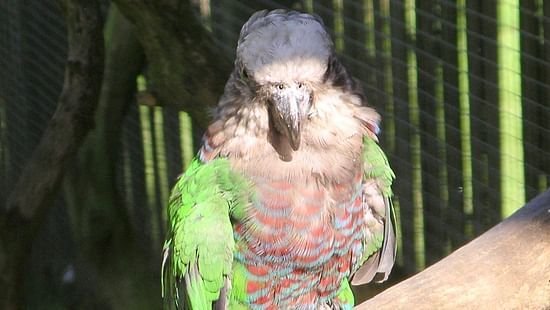
Hawk Headed Parrot:
Scientific Name: Deroptyus accipitrinus
The hawk-headed parrot, also known as the red-fan parrot or guiana hawk-headed parrot is a native of South America, found in the Amazon Basin, in Brazil and Guyana. They have an outgoing and playful nature. They are always active, mischievous, excitable and occasionally highly strung. These parrots are typically found in forest areas, living on fruits from the canopy. They live upto 40 years in the wild.
The hawk-headed parrot, also known as the red-fan parrot or guiana hawk-headed parrot is a native of South America, found in the Amazon Basin, in Brazil and Guyana. They have an outgoing and playful nature. They are always active, mischievous, excitable and occasionally highly strung. These parrots are typically found in forest areas, living on fruits from the canopy. They live upto 40 years in the wild.
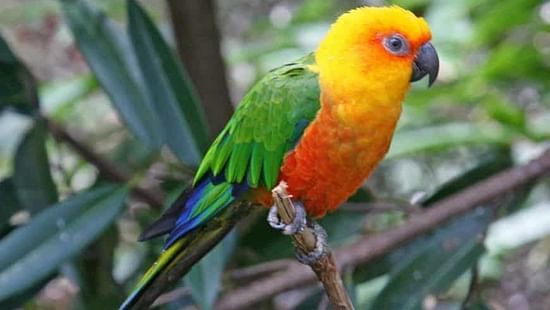
Jenday conure:
Scientific Name: Aratinga jandaya
Conures are reputed as one of the loudest bird species in the world. They also possess high intelligence and can easily pick up several words and phrases. However, their talking ability is underrated. They generally live upto 20 years and move around in pairs or in small groups of 10-15 birds. They find shelter in the tree cavities of the woodlands where the crevices can not just hold their weight, but also be a reliable source of food.
Conures are reputed as one of the loudest bird species in the world. They also possess high intelligence and can easily pick up several words and phrases. However, their talking ability is underrated. They generally live upto 20 years and move around in pairs or in small groups of 10-15 birds. They find shelter in the tree cavities of the woodlands where the crevices can not just hold their weight, but also be a reliable source of food.
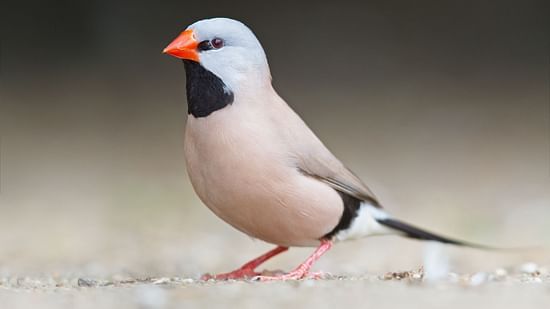
Long-Tailed Finch:
Scientific Name: Poephila acuticauda
Commonly known as the Blackheart Finch, shaft-tail finch, Heck's grassfinch, and Heck's finch, this bird is an estrildid finch commonly spotted in Australia. It is majorly fawn-coloured and has a pale grey head with a distinctive black bib and black eyes. It lives in the dry savannah habitats of Australia and breeds in natural hollows. In a pair of long-tailed finches, the partners share feeding responsibilities. These birds easily adapt to captivity but thrive better in aviaries than in cages.
Commonly known as the Blackheart Finch, shaft-tail finch, Heck's grassfinch, and Heck's finch, this bird is an estrildid finch commonly spotted in Australia. It is majorly fawn-coloured and has a pale grey head with a distinctive black bib and black eyes. It lives in the dry savannah habitats of Australia and breeds in natural hollows. In a pair of long-tailed finches, the partners share feeding responsibilities. These birds easily adapt to captivity but thrive better in aviaries than in cages.
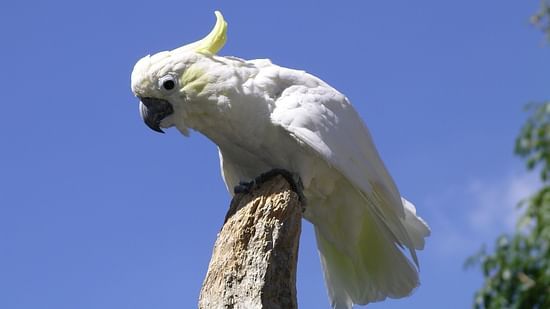
Sulphur cockatoo:
Scientific Name: Cacatua galerita eleonora
The Sulphur Cuckoo is a native of the Aru Islands of Indonesia but has been brought to the Kai Islands as well. The natural habitat of these birds comprises the Savannah, shrubberies, mallee and woodlands. They also build their nests close to the water and tend to move in pairs or close-knit small groups. They mostly stay in pairs during the mating season. These birds are inherently curious and possess a sense of intellect. A 2009 study involving Eleonora Cockatoo found that the species is capable of synchronizing movements to a musical beat.
The Sulphur Cuckoo is a native of the Aru Islands of Indonesia but has been brought to the Kai Islands as well. The natural habitat of these birds comprises the Savannah, shrubberies, mallee and woodlands. They also build their nests close to the water and tend to move in pairs or close-knit small groups. They mostly stay in pairs during the mating season. These birds are inherently curious and possess a sense of intellect. A 2009 study involving Eleonora Cockatoo found that the species is capable of synchronizing movements to a musical beat.
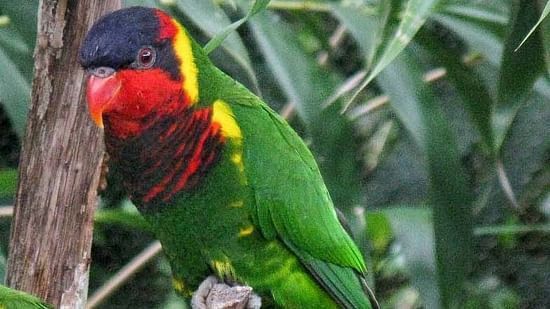
Ornate Lorikeet:
Scientific Name: Trichoglossus ornatus
The ornate lorikeet belongs to the Psittaculidae family and is a monotypic species. It hails from Sulawesi and the small neighboring islands of Indonesia. It is found in forests, woodlands, plantations and in mangroves and can be commonly spotted. Ornate lorikeets thrive better in the forests situated on the mountain edges and overgrown scrubs, and travel to nearby villages. These birds are often seen moving around in small flocks or in pairs. They live on flower blossoms, nectar, pollen, fruits, some greens, and sometimes even insects. They have a striking red beak.
The ornate lorikeet belongs to the Psittaculidae family and is a monotypic species. It hails from Sulawesi and the small neighboring islands of Indonesia. It is found in forests, woodlands, plantations and in mangroves and can be commonly spotted. Ornate lorikeets thrive better in the forests situated on the mountain edges and overgrown scrubs, and travel to nearby villages. These birds are often seen moving around in small flocks or in pairs. They live on flower blossoms, nectar, pollen, fruits, some greens, and sometimes even insects. They have a striking red beak.
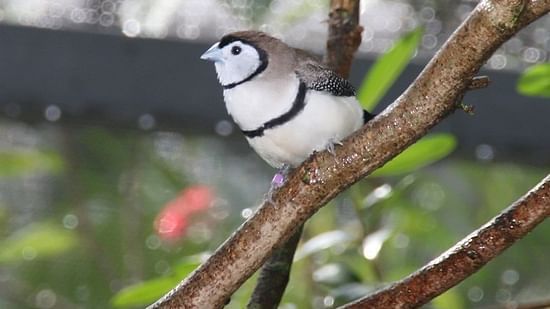
Owl (Bicheno) Finch:
Scientific Name: Poephila bichenovii
The owl finch is an inhabitant of Australia, native to the woodlands, grasslands, and scrublands, though they can also be spotted in city parks. These active flyers travel in groups of 40 and have a keen sense of curiosity. They have excellent adaptivity skills and build their nests with any material. Even though they prefer a covered woven nest to a nest box, they can usually adapt to the situation around them. The male birds are more inclined towards building nests and actively hunt for nesting sites. They thrive well in warm temperatures and do not survive in temperatures lower than 50 degrees fahrenheit.
The owl finch is an inhabitant of Australia, native to the woodlands, grasslands, and scrublands, though they can also be spotted in city parks. These active flyers travel in groups of 40 and have a keen sense of curiosity. They have excellent adaptivity skills and build their nests with any material. Even though they prefer a covered woven nest to a nest box, they can usually adapt to the situation around them. The male birds are more inclined towards building nests and actively hunt for nesting sites. They thrive well in warm temperatures and do not survive in temperatures lower than 50 degrees fahrenheit.
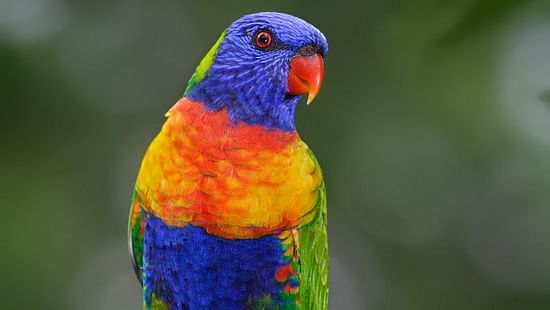
Rainbow Lorikeet:
Scientific Name: Trichoglossus moluccanus
The rainbow lorikeet is a spectacle to watch due to its vibrantly coloured feathers. It is undoubtedly one of the most beautiful birds in the world. These peaceful birds spend most of their lives hunting for food which includes pollen, nectar, fruits, seeds and insects. Their tongues have a unique brush-type tip that aids in drinking nectar. They are often found in small groups in forests and open woodlands along the east coast of Australia, eastern Indonesia, Papua New Guinea, Vanuatu, New Caledonia and the Solomon Islands.
The rainbow lorikeet is a spectacle to watch due to its vibrantly coloured feathers. It is undoubtedly one of the most beautiful birds in the world. These peaceful birds spend most of their lives hunting for food which includes pollen, nectar, fruits, seeds and insects. Their tongues have a unique brush-type tip that aids in drinking nectar. They are often found in small groups in forests and open woodlands along the east coast of Australia, eastern Indonesia, Papua New Guinea, Vanuatu, New Caledonia and the Solomon Islands.

Scarlet Macaw:
Scientific Name:Ara macao
This South American parrot, mostly sporting red, yellow, and blue colours is a member of a larger neotropical parrot family called macaws. It thrives in the humid evergreen forests of tropical South America and has a lifespan of about 75 years when bred in captivity. In the wild, these colourful birds are known to live upto 40-50 years. Flocks of these birds are a rare sight. The more popular sight is that of a lone scarlet macaw flying over the dense canopy of the tropical forests. These birds also have the capability to mimic human speech and communicate amongst each other through honks.
This South American parrot, mostly sporting red, yellow, and blue colours is a member of a larger neotropical parrot family called macaws. It thrives in the humid evergreen forests of tropical South America and has a lifespan of about 75 years when bred in captivity. In the wild, these colourful birds are known to live upto 40-50 years. Flocks of these birds are a rare sight. The more popular sight is that of a lone scarlet macaw flying over the dense canopy of the tropical forests. These birds also have the capability to mimic human speech and communicate amongst each other through honks.

Yellow Naped Amazon:
Scientific name: Amazona Auropalliata
The yellow-naped amazon is often considered to be a subspecies of yellow-crowned amazon. They have the potential to mimic sounds. They have a distinctive green forehead and crown, and a striking yellow band across their lower nape. Their beak is dark grey with a paler shade towards the end. They also have dark grey feet. They are highly sociable birds and enjoy interacting with humans.
The yellow-naped amazon is often considered to be a subspecies of yellow-crowned amazon. They have the potential to mimic sounds. They have a distinctive green forehead and crown, and a striking yellow band across their lower nape. Their beak is dark grey with a paler shade towards the end. They also have dark grey feet. They are highly sociable birds and enjoy interacting with humans.

Green Turaco:
Scientific Name: Musophagidae
These South African birds are often known as louries. Green Turacos are semi-zygodactylous which means that they can switch their fourth toe back and forth. In some species, the second and third toes are conjoined. The turacos have distinguishable unique pigments that give them bright green and red feathers. The birds lay two eggs with every breeding cycle and are known to move in pairs at the time. These birds often camouflage with the treetops due to their long green tails.
These South African birds are often known as louries. Green Turacos are semi-zygodactylous which means that they can switch their fourth toe back and forth. In some species, the second and third toes are conjoined. The turacos have distinguishable unique pigments that give them bright green and red feathers. The birds lay two eggs with every breeding cycle and are known to move in pairs at the time. These birds often camouflage with the treetops due to their long green tails.

Yellowish-Streaked Lory
Scientific Name: Chalcopsitta scintillate
This species of the parrot in the family Psittaculidae is native to the Aru Islands and southern New Guinea. The natural habitats of these birds are subtropical or tropical moist lowland forests and subtropical or tropical mangrove forests. These birds have an endangered status, owing to which any suitable specimen fit to be released into the natural habitat, must be placed in a well-managed breeding program to ensure the continuation of its species.
This species of the parrot in the family Psittaculidae is native to the Aru Islands and southern New Guinea. The natural habitats of these birds are subtropical or tropical moist lowland forests and subtropical or tropical mangrove forests. These birds have an endangered status, owing to which any suitable specimen fit to be released into the natural habitat, must be placed in a well-managed breeding program to ensure the continuation of its species.

Zebra Dove:
Scientific Name:Geopelia striata
This southeast Asian dove belongs to the dove family Columbidae. This small bird has a long tail and has a predominantly brownish-grey colour with black and white barring. They have a soothing coo that sounds very pleasant to the ears. They preferably roost in the coconut palms in the Malay Peninsula at night.
This southeast Asian dove belongs to the dove family Columbidae. This small bird has a long tail and has a predominantly brownish-grey colour with black and white barring. They have a soothing coo that sounds very pleasant to the ears. They preferably roost in the coconut palms in the Malay Peninsula at night.
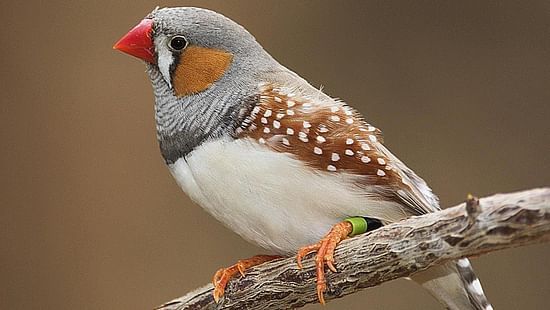
Zebra Finch:
Scientific Name: Taeniopygia guttata castanotisThese are the most native finches of Australia. They are found in the grasslands and forests across the continent barring the coldest and most tropical areas. These birds have benefitted from human interaction. They feed on water from man-made dams and from lands cleared for farming.
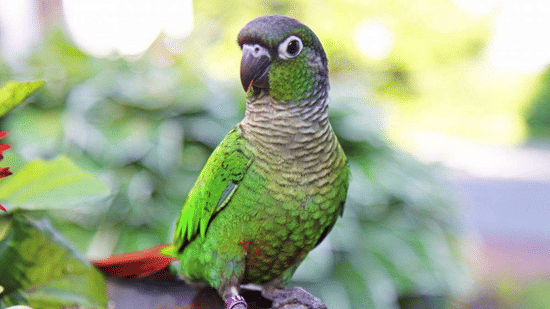
Green-Cheeked Conure:
Scientific name: Pyrrhura molinae
The green-cheeked Conure is native to forests and woodlands areas of Brazil, Bolivia, Argentina and Paraguay. These birds are very vibrant and colourful. They have dark grey-blackish feathers on their head, with green cheeks and grey feet. Their tail feather is maroon. These birds are full of antics, and love to goof around by hanging upside down and clamouring together on cage bars and are known to move in flocks of 10.
The green-cheeked Conure is native to forests and woodlands areas of Brazil, Bolivia, Argentina and Paraguay. These birds are very vibrant and colourful. They have dark grey-blackish feathers on their head, with green cheeks and grey feet. Their tail feather is maroon. These birds are full of antics, and love to goof around by hanging upside down and clamouring together on cage bars and are known to move in flocks of 10.
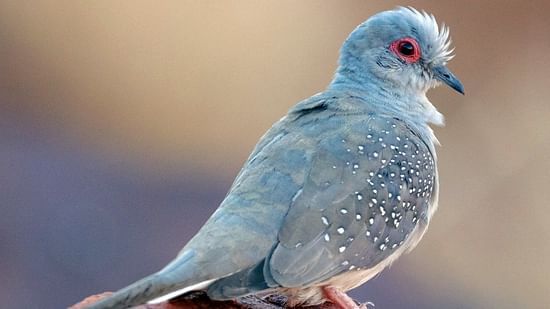
Diamond Doves:
Scientific name: Geopelia cuneata
Diamond Doves are identified by the several white spots dotting their wings. These birds are native to Australia where they live in arid deserts in the north and central parts. Diamond doves are one of the smallest dove species on the continent. Their upper bodies are mostly brown-grey while their bellies are cream coloured. They hunt for food in small groups or in pairs and feed on seeds. On rare occasions, they also feed on insects.
Diamond Doves are identified by the several white spots dotting their wings. These birds are native to Australia where they live in arid deserts in the north and central parts. Diamond doves are one of the smallest dove species on the continent. Their upper bodies are mostly brown-grey while their bellies are cream coloured. They hunt for food in small groups or in pairs and feed on seeds. On rare occasions, they also feed on insects.
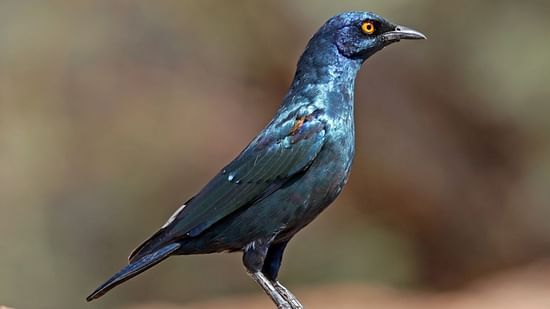
Cape Glossy Starling:
Scientific name:Lamprotornis niten
The cape glossy starling gets its name from its sheen reflected from its iridescent dark blue feathers when the sun shines on the bird’s body. Another striking feature of the bird is its bright orange-yellow eyes which contrast the dark colours donning its body. The male birds are slightly larger in size than their female counterparts. They live on items that are commonly available including nectar, fruits and a variety of insects. The cape glossy starling prefers to live by the riverine bushes where they have easier access to food and water. These birds are monogamous and find shelters within the cavities of trees or the abandoned holes of woodpeckers or barbets. Their eggs are generally pale blue in colour and come in clusters of two or four.
The cape glossy starling gets its name from its sheen reflected from its iridescent dark blue feathers when the sun shines on the bird’s body. Another striking feature of the bird is its bright orange-yellow eyes which contrast the dark colours donning its body. The male birds are slightly larger in size than their female counterparts. They live on items that are commonly available including nectar, fruits and a variety of insects. The cape glossy starling prefers to live by the riverine bushes where they have easier access to food and water. These birds are monogamous and find shelters within the cavities of trees or the abandoned holes of woodpeckers or barbets. Their eggs are generally pale blue in colour and come in clusters of two or four.

Palm Cockatoo:
Scientific Name: Probosciger aterrimus
Palm cockatoos are native residents of the rainforests of New Guinea and north Queensland. These birds can grow upto the length of 60 cm, which ranks them the highest in terms of size for cockatoos. The red colour on their cheeks changes when the birds express excitement. These birds have unique tactics for survival. For instance, the males of the species are known to mark their territories by breaking off a large stick and drumming the tree to produce a loud noise that can be heard from 100 m away. Their bills, some of the largest in the bird kingdom, are of the strong build which helps them break the shells of hard nuts and seeds.
Palm cockatoos are native residents of the rainforests of New Guinea and north Queensland. These birds can grow upto the length of 60 cm, which ranks them the highest in terms of size for cockatoos. The red colour on their cheeks changes when the birds express excitement. These birds have unique tactics for survival. For instance, the males of the species are known to mark their territories by breaking off a large stick and drumming the tree to produce a loud noise that can be heard from 100 m away. Their bills, some of the largest in the bird kingdom, are of the strong build which helps them break the shells of hard nuts and seeds.
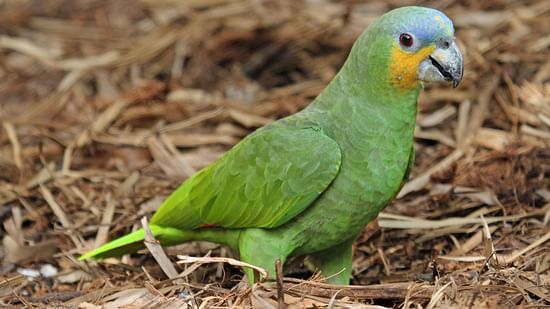
Orange Winged Amazon:
Scientific name: Amazona Amazonica
Endemic to South America, Columbia, southern Peru, Bolivia and Central Brazil, the orange-winged amazons are predominantly green parrots with blue and yellow feathers on the head. However, their upper mandible is made of grey with orange feathers in their wings and tails. The males and females appear identical externally. They build their nests in the cavities of the trees. They have a very affectionate personality and are generally very entertaining birds. They are quite popular amongst our guests due to their antics and abilities to mimic speech.
Endemic to South America, Columbia, southern Peru, Bolivia and Central Brazil, the orange-winged amazons are predominantly green parrots with blue and yellow feathers on the head. However, their upper mandible is made of grey with orange feathers in their wings and tails. The males and females appear identical externally. They build their nests in the cavities of the trees. They have a very affectionate personality and are generally very entertaining birds. They are quite popular amongst our guests due to their antics and abilities to mimic speech.

Monk Parakeet:
Scientific name: Myiopsitta Monachus
The monk parakeet or the quaker parrot is a small, bright-green parrot with a greyish chest and a greenish-yellow abdomen. It thrives in the temperate and subtropical areas of Argentina, and its surrounding countries in South America. The females of this species are a tad bit smaller than their male counterparts. They grow up to 29cm long on average and have a 48 cm wingspan.
The monk parakeet or the quaker parrot is a small, bright-green parrot with a greyish chest and a greenish-yellow abdomen. It thrives in the temperate and subtropical areas of Argentina, and its surrounding countries in South America. The females of this species are a tad bit smaller than their male counterparts. They grow up to 29cm long on average and have a 48 cm wingspan.

Star Finch:
Scientific name: Neochmia Ruficauda
The male star finch is easily distinguishable from the female of the species owing to their red face mask. The males also sing a song while stretching their neck and fluffing their head feathers. These birds are native to Australia where they live in grasslands and dry savannah habitats. The species also shows different mutations with some varieties showing yellow and cinnamon colours.
The male star finch is easily distinguishable from the female of the species owing to their red face mask. The males also sing a song while stretching their neck and fluffing their head feathers. These birds are native to Australia where they live in grasslands and dry savannah habitats. The species also shows different mutations with some varieties showing yellow and cinnamon colours.
Come meet these fascinating flying birds and have a blast at the best bird park in Maharashtra!
Visit our other attraction:
 |